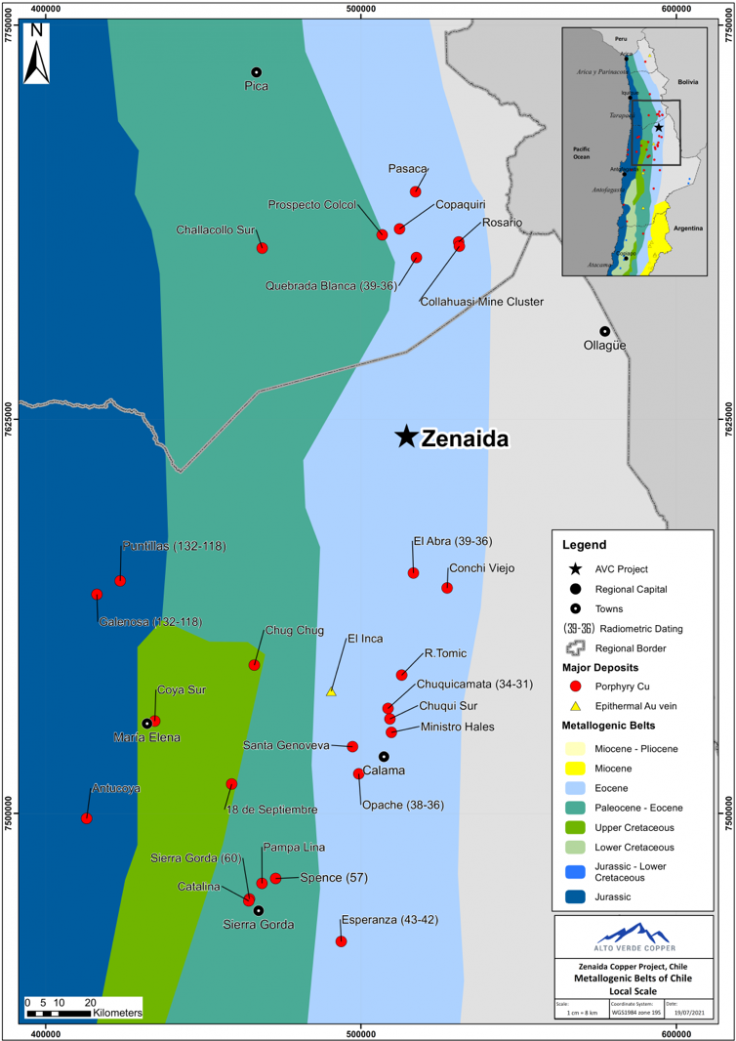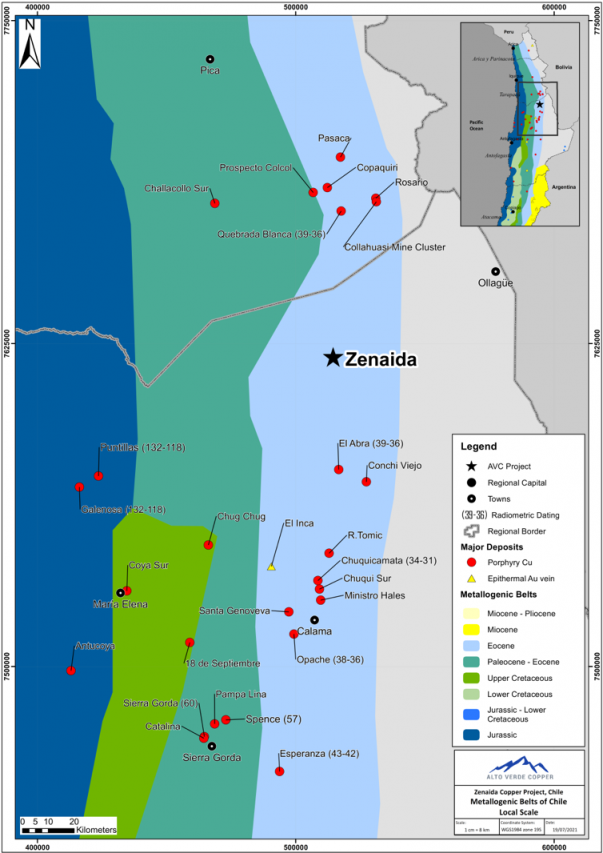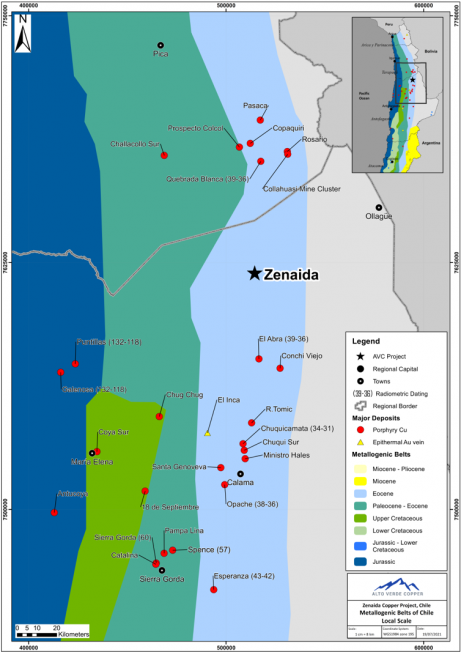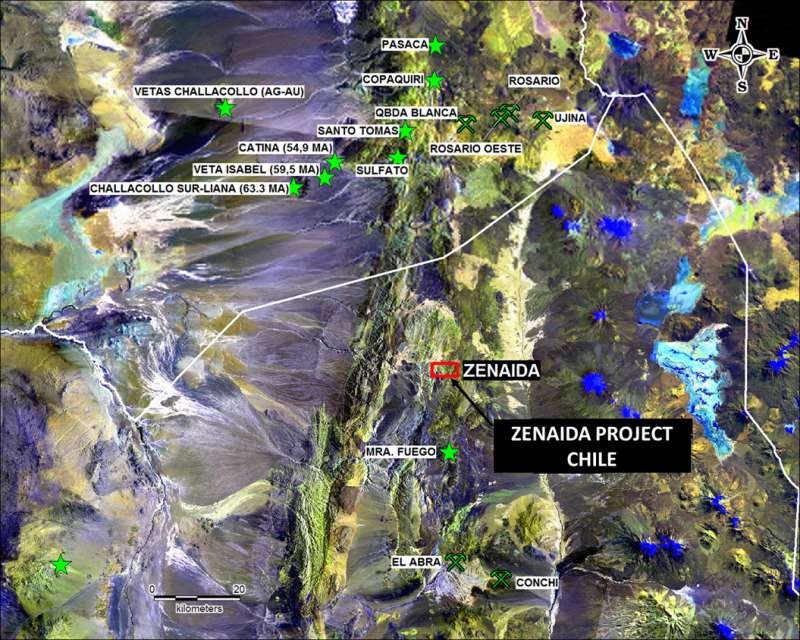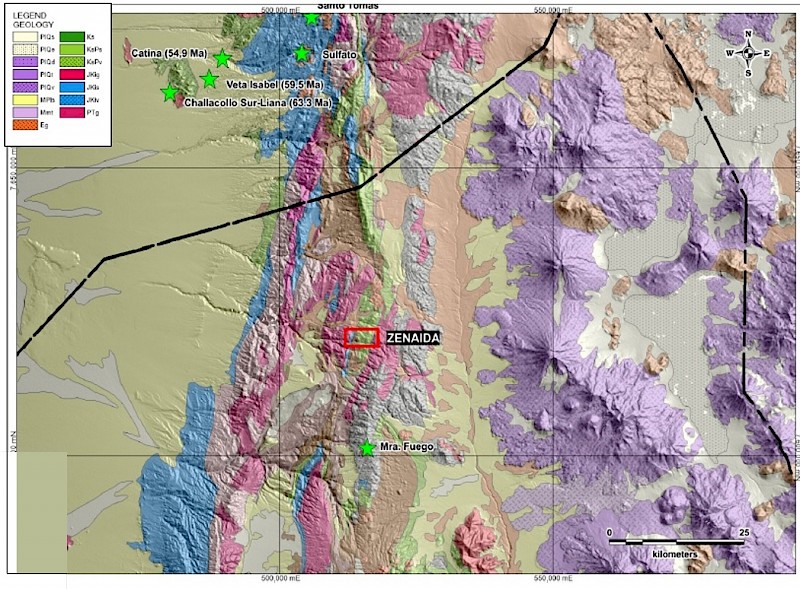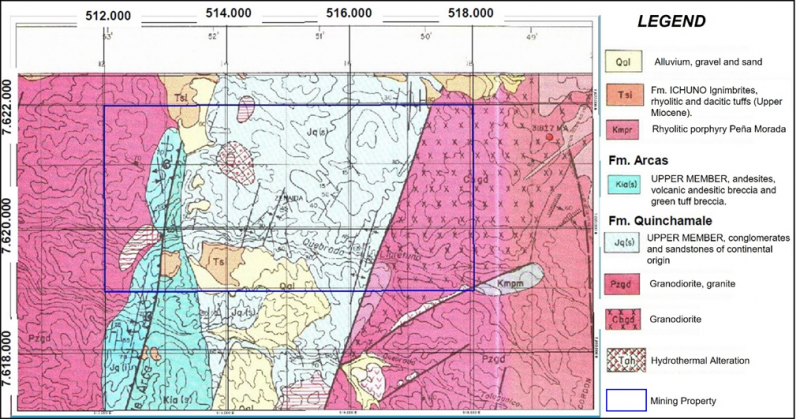-
Zenaida
Overview
Target Deposit Type: Copper Porphyry (PCD)
Stage: Early-Stage Exploration
Ownership: 100%, NSR 1.0%*
Location: Antofagasta, Chile
Size: 1,800 ha
Elevation: 3,900m
The Zenaida Project is a greenfield property in early-stage exploration, with very little known historical exploration work completed on the property. The region around the project has historically been and is currently very active in terms of mineral exploration and mining. It is located in the most prolific strip of copper porphyry in northern Chile, the Eocene-Oligocene belt.
Location & Infrastructure
The Zenaida project is located 1,335 km north of the capital city of Chile, Santiago, in the II Region of Antofagasta. The Project is located within the province of El Loa and the commune of Calama, approximately 105 km north of the city of Calama, 44 km north of the El Abra deposit and 58 km south of the cluster Collahuasi-Quebrada Blanca. The Project is accessible from Calama by the paved road that leads to the El Abra deposit and then by a secondary well-maintained dirt road which reaches the east end of the property.
Calama is considered the Mining Capital of Chile resulting in superior infrastructure in the region. It has excellent services and supplies, with an international airport, and is connected to the rest of the country by the Pan-American highway. It has rail transport with boarding and disembarking services in the nearby ports in Antofagasta, Mejillones and Tocopilla, and also has the Norte Grande Interconnected Electric Power System (SING) that extends between the Tarapacá and Antofagasta regions.
The local climate is high desert resulting in cold and dry winters and a temperate summer, with temperatures from summer to autumn (November to April) ranging between 0 ° C to 25 ° C and higher and winter to spring (May to October) ranging from a few degrees below zero to 15 ° C. Given the temperate nature of the region, exploration programs can be carried out throughout the year.
Geology & Exploration
The Project consists of 6 mining concessions covering 1,800 ha located in the Morphostructural zone known as Cordillera Domeyko (also known as Pre-Cordillera), in the north of the Eocene Oligocene strip. This strip contains the highest concentration of copper in the world, with at least 220 Mt of copper considering resources, reserves and production. It is the most economically significant Cu-Mo porphyry belt in Chile and contains the largest known copper deposits in the world.
Metallogenic Location of Zenaida
The main geological characteristic is the spatial relationship with the Domeyko fault system, the deposits occur along the master faults of this system (NS orientation) and in the NW orientation secondary faults, this genetic relationship has been used for exploration of new deposits.
The regional geology is dominated by volcanic rocks of the Collahuasi formation, made up of andesites, daciandesites and rhyolites, as well as andesitic breccias and smaller sandstone intercalations. In a more western zone, continental clastic sedimentary rocks of the Tolar formation, from the Upper Cretaceous, are seen. Manifestations of Paleozoic granitoid intrusive rocks are recognized in the area, while other intrusive units, both dioritic, granodioritic and monzodioritic, would correspond to tertiary units. A wide coverage of Miocene ignimbrites is dominant in much of the environment, particularly in the eastern part of the area.
Regional Geology of Zenaida
The local geology in the central part of the property is covered by conglomerates and sandstones of continental origin from the Quinchamale Jq (s) formation, covered by post-mineral coverage of alluvial material, sands and gravel, alternating with Miocene ignimbrites from the Ichuno formation, where some areas with hydrothermal alteration are observed in isolation. The western and southwestern part of the property presents andesite outcrops and andesitic breccia from the Arcas formation.
Geology of the Chitihua Quadrangle
As illustrated in the diagram above, intrusive rocks of Granodioritic to granitic composition from the Paleozoic and fresh rocks are observed to the extreme east and extreme west which are controlled by faults in the direction NS to N25°E, associated with the Domeyko fault system.
The geology observed in Zenaida is very similar to that observed in the Collahuasi deposit, with the same type of outcropping, evidence of areas with hydrothermal alteration with strong structural control, with faults associated with the Domeyko fault system.
The Company's initial plans at the site include a geological mapping and geochemical sampling campaign, followed by a detailed high-resolution magnetometry survey. The results of this campaign will be used to carry out IP and geophysics surveys to plan the location of the collars for a follow-up drill campaign.
Project Ownership*
Alto Verde Copper Inc., acquired 100% of the Tres Marías, Pitbull and Zenaida mining concessions from Minera Freeport-McMoRan South America Limitada (“MFMSA”), a wholly owned subsidiary of Freeport-McMoRan Inc. The Tres Marías project is subject to a purchase option by MFMSA such that upon completing US$5 million of qualifying exploration expenditures on the property within 5 years, MFMSA shall have the right to acquire either a 51% interest in MTM’s share capital for US$12.5 million, a 49% interest in MTM’s share capital for a nominal amount, OR not acquire any interest in MTM. If MFMSA acquires a 51% interest in MTM’s share capital, Alto Verde will be granted a 0.5% NSR royalty over the Property. If MFMSA acquries a 49% interest or 0% interest in MTM’s share capital, MFMSA will be granted a 1.0% NSR royalty over the Property. MFMSA also holds a 1% NSR Royalty on both the Pitbull and Zenaida properties.Projects

Register to receive news via email from Interra Copper Corp.
* Required FieldsForm not found

